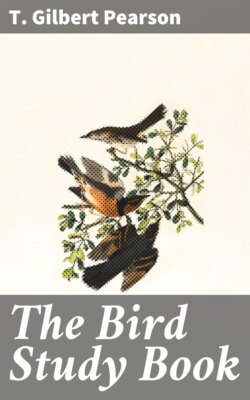Читать книгу The Bird Study Book - T. Gilbert Pearson - Страница 7
На сайте Литреса книга снята с продажи.
The Fox that Followed the Footsteps
ОглавлениеTable of Contents
Going Afield.—It is rarely necessary to go far afield to begin the study of birds. Often one may get good views of birds from one's open window, as many species build their nests close to the house when the surroundings are favourable. Last spring I counted eighteen kinds of birds one morning while sitting on the veranda of a friend's house, and later found the nests of no less than seven of them within sight of the house. When one starts out to hunt birds it is well to bear in mind a few simple rules. The first of these is to go quietly. One's good sense would of course tell him not to rush headlong through the woods, talking loudly to a companion, stepping upon brittle twigs, and crashing through the underbrush. Go quietly, stopping to listen every few steps. Make no violent motions, as such actions often frighten a bird more than a noise. Do not wear brightly coloured clothing, but garments of neutral tones which blend well with the surroundings of field and wood. It is a good idea to sit silently for a time on some log or stump, and soon the birds will come about you, for they seldom notice a person who is motionless. A great aid to field study is a good Field Glass. A glass enables one to see the colours of small birds hopping about the shrubbery, or moving through the branches of trees. With its aid one may learn much of their movements, and even observe the kind of food they consume. A very serviceable glass may be secured at a price varying from five to ten dollars. The National Association of Audubon Societies, New York City, sells a popular one for five dollars. If you choose a more expensive, high-powered binocular, it will be found of greater advantage when watching birds at a distance, as on a lake or at the seashore.
Notebooks.—The bird student should early acquire the custom of making notes on such subjects as are of special interest. In listening to the song or call of some unknown bird, the notes can usually be written down in characters of human speech so that they may be recalled later with sufficient accuracy to identify the singer. It is well to keep a list of the species observed when on a trip. For many years in my field excursions I have kept careful lists of the birds seen and identified, and have found these notes to be of subsequent use and pleasure. In college and summer-school work I have always insisted on pupils cultivating the notebook habit, and results have well justified this course.
In making notes on a bird that you do not know it is well to state the size by comparing it with some bird you know, as, for example, "smaller than an English Sparrow," "about the size of a Robin," and so on. Try to determine the true colours of the birds and record these. Also note the shape and approximate length of the bill. This, for example, may be short and conical like a Canary's, awl-shaped like the bill of a Warbler, or very long and slender like that of a Snipe. By failing to observe these simple rules the learner may be in despair when he tries to find out the name of his strange bird by examining a bird book, or may cause some kindly friend an equal amount of annoyance.
